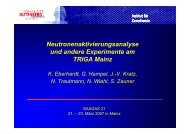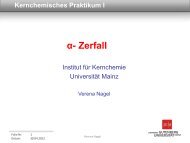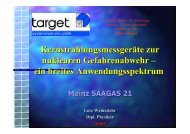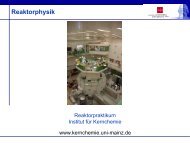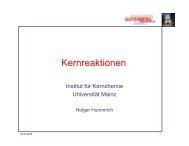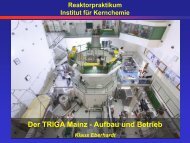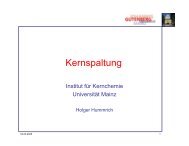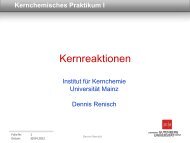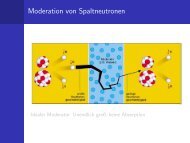jahresbericht 2007 - Institut für Kernchemie - Johannes Gutenberg ...
jahresbericht 2007 - Institut für Kernchemie - Johannes Gutenberg ...
jahresbericht 2007 - Institut für Kernchemie - Johannes Gutenberg ...
You also want an ePaper? Increase the reach of your titles
YUMPU automatically turns print PDFs into web optimized ePapers that Google loves.
140-Praseodym: A potential radionuclide for perfusion measurements ?<br />
Buchholz H-G 2 , Filosofov D 3 , Zhernosekov KP 4 , Hauser H 6 , Thews O 5 ,<br />
Schreckenberger M 2 , Rösch F 1<br />
1 <strong>Institut</strong>e of Nuclear Chemistry, University of Mainz, Fritz-Strassmann-Weg 2, 55128 Mainz; 2 Clinic of Nuclear Medicine,<br />
Langenbeckstr. 1, 55131 Mainz University, Mainz; 3 Joint <strong>Institut</strong>e of Nuclear Research, Laboratory of Nuclear<br />
Problems, Dubna, Russian Federation, 4 <strong>Institut</strong>e of Radio Chemistry, LM University Munich, Munich; Germany,<br />
5 <strong>Institut</strong> für Physiologie und Pathophysiologie, Mainz,<br />
6 German Cancer Research Center, Im Neuenheimer Feld 280, 69120 Heidelberg, Germany<br />
Objectives: In research application O-15 water has<br />
been used for many years to assess cerebral and myocardial<br />
perfusion with PET. Generally, radioisotopes<br />
with short half-lifes can be considered to be used as perfusion<br />
markers. However, due to the short half-life i.e. 2<br />
min for O-15, this tracers can only be used in PET centers<br />
with onsite cyclotron. 140-Praseodym ( 140 Pr, halflife<br />
3.39 min) as daughter radioisotope from 140-<br />
Neodym ( 140 Nd, half-life: 3.37 d) can be produced in a<br />
generator system and therefore used in PET lacking a<br />
nearby cyclotron. Aim of this study was to evaluate the<br />
feasibility of 140 Pr for perfusion studies in rats using<br />
small animal PET scanner.<br />
Methods: 140 Pr was derived from a 140 Nd/ 140 Pr radionuclide<br />
generator as published [1]. 140 Nd was produced at<br />
the DKFZ Heidelberg cyclotron via 139 Pr(p,2n) reaction<br />
on Praseodym metal.<br />
3 male SD rats were scanned with the microPET Focus<br />
120 small animal PET scanner. 140 Pr was eluted with<br />
about 0.5 ml of 10 -3 M DTPA from the 140 Nd/ 140 Pr generator<br />
and immediately injected into the jugular vein.<br />
Dynamics were started simultaneously with tracer injection<br />
of about 5-10 MBq 140 Pr-DTPA. 10-min scans were<br />
derived from brain and body areas. Additionally, tumor<br />
perfusion of one rat bearing DS sarcoma on both hind<br />
foot dorsum was imaged.<br />
Results: Imaging of the abdominal area showed that<br />
140 Pr-DTPA was rapidely washed out by the kidneys.<br />
Time-activity curves of brain and neck regions-ofinterests<br />
demonstrate that 140 Pr-DTPA did not enter the<br />
blood-brain barrier (BBB) (Fig. 1). Due to the limited<br />
activity the reconstructed images were noisy and perfusion<br />
could not properly quantified.<br />
activity / kBq/ml<br />
35<br />
30<br />
25<br />
20<br />
15<br />
10<br />
5<br />
brain<br />
unspecific<br />
0<br />
0 100 200 300 400<br />
scan time / sec<br />
Fig. 1: Time-activity curves of the brain and of the neck and<br />
shoulder area (unspecific)<br />
On the other hand, perfusion of the tumor was visible,<br />
cf. Fig. 2. TAC are illustrated in Fig. 3.<br />
Fig. 2: Coronal (left) and transversal (right) µ-PET sum imaging<br />
of 140 Pr-DTPA accumulation in a DS-tumor bearing rat<br />
activity / kBq/ml<br />
60<br />
50<br />
40<br />
30<br />
20<br />
10<br />
0 100 200 300 400 500 600<br />
scan time / sec<br />
tail(unspec)<br />
tu1<br />
tu2<br />
Fig. 3: Time-activity curves for the two tumors and the tail region<br />
(unspecific)<br />
Conclusions: 140 Pr-DTPA failed to measure brain perfusion<br />
as the complex is not passing the BBB. Brain<br />
tumor imaging may, however, be an option due to the<br />
damaged BBB of the tumors.<br />
Remarkable tumor perfusion in DS sarcoma was detected,<br />
demonstrating that 140 Pr-DTPA eluted from the<br />
140 Nd/ 140 Pr generator indicates regional tumor perfusion.<br />
Further perfusion studies with much more 140 Pr-DTPA<br />
activity resulting in better count statistics are needed to<br />
validate these findings.<br />
References<br />
[1] KP Zhernosekov, DV Filosofov, SM Qaim, F Rösch. A 140 Nd/ 140 Pr<br />
radionuclide generator based on physico-chemical transitions in 140 Pr<br />
complexes after electron capture decay of 140 Nd-DOTA. Radiochim<br />
Acta 95 (<strong>2007</strong>) 319-327<br />
- B33 -



